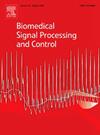肌电驱动神经肌肉骨骼模型中肌间一致性改善肌肉力矩估计的可行性研究
IF 4.9
2区 医学
Q1 ENGINEERING, BIOMEDICAL
引用次数: 0
摘要
目前的肌肉骨骼模型经常过度简化肌肉激活的神经策略,可能导致对肌肉力量的不满意估计。许多运动控制方面的研究已经证实,中枢神经系统通过向协同肌肉发送共同驱动来同步肌肉激活,这可以通过肌间相干性(两个肌电图信号之间的频率相关性)来测量。随着人们对理解肌肉在运动协调过程中如何同步的兴趣的增长,利用肌肉间的一致性进入肌肉骨骼模型代表了一种创新的方法。这可以提高肌肉用力估计的准确性,并引入一个有生理意义的运动控制成分。在这项研究中,我们引入了一种新的方法,将肌电信号分解为肌间相干性的共同和独立分量,并将它们整合到肌电信号驱动模型中来估计肌肉力矩。利用24名健康受试者进行水平上肢伸展的数据,我们估计了驱动肘部的四个主要肌肉的力矩,并将这些估计与传统的肌电驱动模型(全波整流信号包络)的估计进行了比较。我们的研究结果表明,结合肌间相干性显著增强了运动数据跟踪,提高了肌肉力矩估计对模型参数变化的鲁棒性,解决了传统肌电驱动模型的主要局限性。此外,拮抗剂肌矩更准确地表示,从而产生更真实的共收缩指数值。通过将神经控制策略通过肌间一致性整合到肌肉骨骼模型中,所提出的方法提供了更准确的肌肉协调表示。我们建议未来的神经肌肉骨骼模型纳入肌间一致性,以提高肌肉努力估计的生理真实性。本文章由计算机程序翻译,如有差异,请以英文原文为准。

A feasibility study of leveraging intermuscular coherence in EMG-driven neuromusculoskeletal modeling to improve muscle moment estimation
Current musculoskeletal models often oversimplify the neural strategies underlying muscle activation, potentially leading to unsatisfactory estimates of muscle forces. Numerous studies in motor control have established that the central nervous system synchronizes muscle activation by sending a common drive to synergistic muscles, measurable through intermuscular coherence – the frequency correlation between two EMG signals. As interest grows in understanding how muscles synchronize during movement coordination, leveraging intermuscular coherence into musculoskeletal models represents an innovative approach. This could enhance the accuracy of muscle effort estimation and introduce a physiologically meaningful component of motor control. In this study, we introduce a new method that decomposes EMG signals into common and independent components, informed by intermuscular coherence, and integrates them into an EMG-driven model to estimate muscle moments. Using data from twenty-four healthy subjects performing horizontal upper limb extensions, we estimated moments of the four main muscles actuating the elbow and compared these estimations with those from a traditional EMG-driven model informed by full-wave rectified signal envelopes. Our results demonstrate that incorporating intermuscular coherence significantly enhanced kinetic data tracking and improved the robustness of muscle moment estimations against variations in model parameters, addressing a major limitation of traditional EMG-driven models. Furthermore, antagonist muscle moments were more accurately represented, resulting in more realistic co-contraction index values.
By integrating neural control strategies via intermuscular coherence into musculoskeletal models, the proposed approach offers a more accurate representation of muscle coordination. We recommend that future neuromusculoskeletal models incorporate intermuscular coherence to improve physiological realism of muscle effort estimations.
求助全文
通过发布文献求助,成功后即可免费获取论文全文。
去求助
来源期刊

Biomedical Signal Processing and Control
工程技术-工程:生物医学
CiteScore
9.80
自引率
13.70%
发文量
822
审稿时长
4 months
期刊介绍:
Biomedical Signal Processing and Control aims to provide a cross-disciplinary international forum for the interchange of information on research in the measurement and analysis of signals and images in clinical medicine and the biological sciences. Emphasis is placed on contributions dealing with the practical, applications-led research on the use of methods and devices in clinical diagnosis, patient monitoring and management.
Biomedical Signal Processing and Control reflects the main areas in which these methods are being used and developed at the interface of both engineering and clinical science. The scope of the journal is defined to include relevant review papers, technical notes, short communications and letters. Tutorial papers and special issues will also be published.
 求助内容:
求助内容: 应助结果提醒方式:
应助结果提醒方式:


